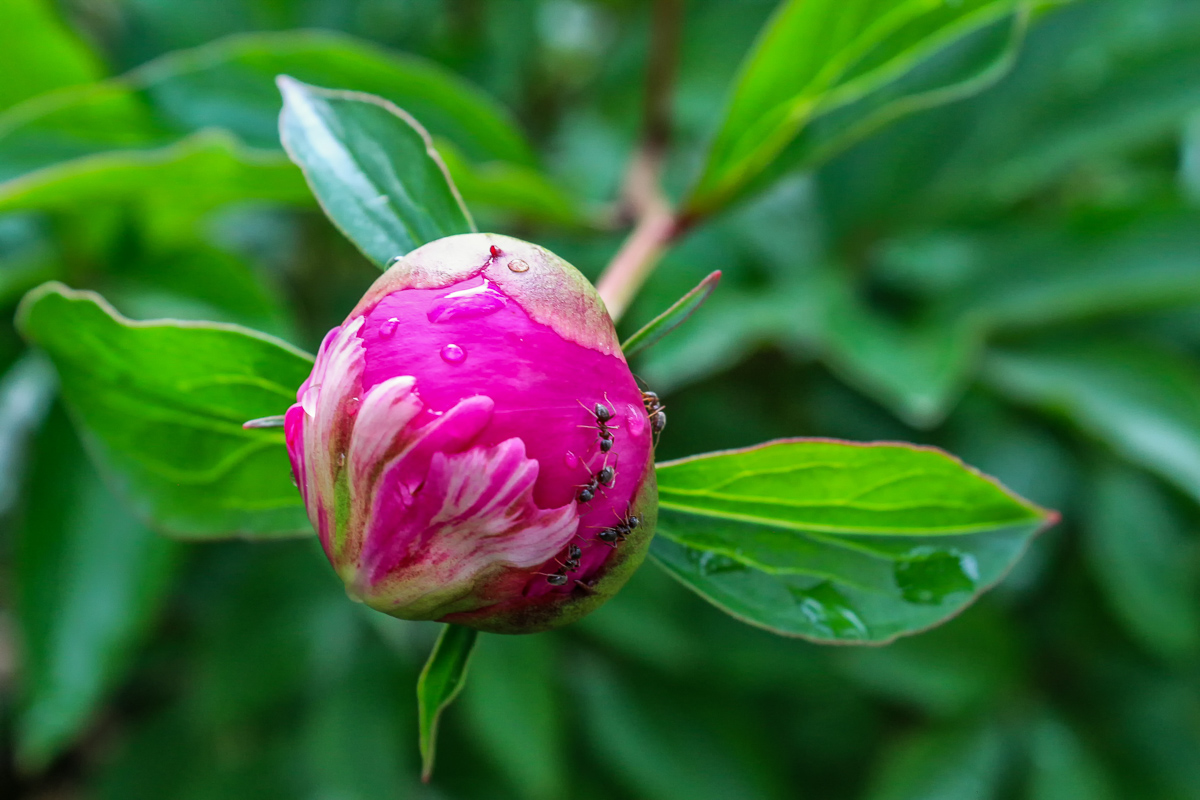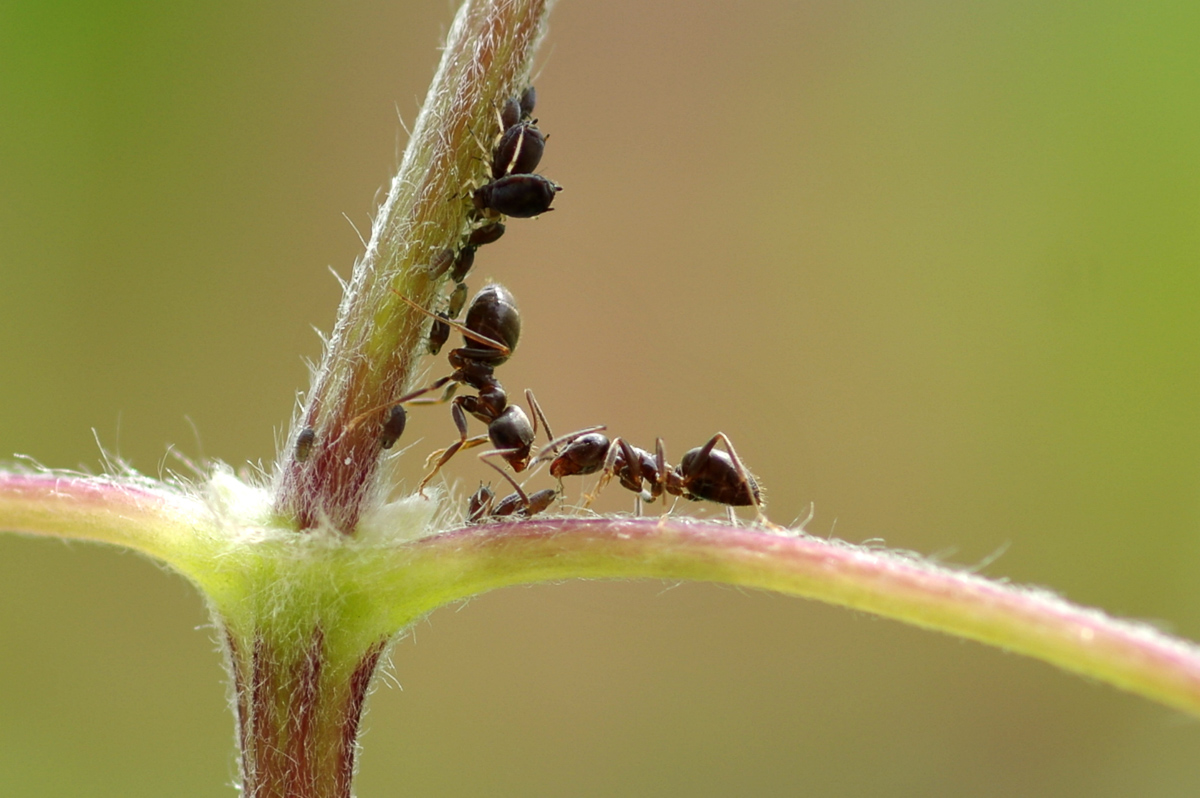
Ants
Beneficial but can be annoying
While they can be annoying at picnics, ants are a beneficial insect and will reduce unwanted pest problems in your garden. Saskatchewan is home to over 90 different species of ants which belong to an order of insects called Hymenoptera. Some common ants include pavement ants, carpenter ants, red and black ants.
Ants prey on soft-bodied insects like grubs, chinch worms, earthworms, caterpillars, aphids, scale, whiteflies, mealybugs and cutworms. A few species living in grasslands areas eat seeds. Ants work collectively and use scent trails (pheromones) to follow each other to food sources, like wood piles, compost piles or garbage. Ants themselves are high in protein and are an important source of food for insects like dragonflies, wasps and beetles, as well as many amphibians, birds and mammals.
Their busy, organized colonies aerate soil. Studies have shown that ant colonies may improve soil pH, increase soil organic matter and improve the uptake of soil nutrients. Some plants depend on ants for dispersing seeds.

Life cycle
Ants are social insects which live together in large colonies or nests. Colonies are long-lived with many generations of ants living within it. Their preferred habitat is dry soil which is low in organic matter.
Much like bees (a relative), the queen is the only member of the colony that lays eggs. Worker ants are all wingless, sterile females. Hardworking, strong and fierce, they protect the colony, forage for food and care for larvae and pupae. When the weather is just right in spring or summer, specially reared winged males (kings) and females fly out of the colony and mate. These are called nuptial flights. Honeymoon over, the kings die and the fertilized females, now new queens, shed their wings and find new places to start their own colonies.
The cycle begins again with the new queen laying eggs. She cares for this first generation herself, which are small sterile female workers called nanitics. These will help her expand the colony and rear more generations of worker ants and breeding kings and queens.
In the fall, most ants close the entry to their colonies and tunnel deep into the ground where soil temperatures are moderate over winter. Others, like carpenter ants which live in decaying wood, have the ability to hibernate or become dormant in winter by changing the chemistry of their internal fluids so they do not freeze.
Ant Management
Ants can be a cosmetic problem in the lawn or garden or a nuisance in the house. Most ants do not eat plants and will not kill your lawn or garden plants. Large nests make the lawn lumpy and less favorable for picnics.
An over-abundance of ants is a sign of a perfect habitat for ants, especially if the soil in your yard or garden is dry and low in organic matter. Here are some pesticide-free strategies for keeping them in check.
- Reduce ant habitat conditions:
- Increase organic matter in your garden and lawn.
- Mulch your garden beds.
- Keep soil and mulch moist.
- Keep garbage away from ant colonies. They will eat BBQ leftovers or picnic foods if easily accessible.
Lawn
- Check your thatch – if it is thicker than 3 cm (1”), de-thatch to allow better moisture penetration.
- Add 3 cm (1”) of compost on top of your lawn every year to increase soil organic matter. Organic matter helps with soil structure and helps to hold moisture in sandy soil.
- Keep your lawn fairly moist for an extended period of time – water daily for 7 - 10 days. Ants like it dry. After that, water deeply once a week to keep your lawn healthy.
- Lawn that is cut too short tends to dry out fast. Set your mower blade at the highest setting.
- Disturb large ant mounds with a rake or shovel. Do this every 2 days to encourage them to move along.

In the Garden
- Disturb large ant mounds with a shovel or rake.
- Keep the garden moist as per above.
- A thick layer of mulch (at least 10 cm or 4”) on all of your flower or vegetable beds helps to retain soil moisture and discourages dry, arid conditions preferred by ants. Even if ants aren’t living in your flower beds, natural mulches encourage predatory insects that eat both ants and aphids, which will help control your overall ant population. It’s important to note that natural controls only work if you keep your garden pesticide-free.
- If you mulch your vegetable garden, it is important you remove this mulch before tilling each year. We highly recommend you consider switching to a no-till garden set up (visit https://gardening.usask.ca/gardenline/how-to.php#Basicgardening for more information on No-Till Gardening). Not only will this help with ant problems, it has many other benefits as well.
- If your yard has few trees, shrubs and other plants, plant more to attract birds into your yard. Birds consume a lot of ants. Biodiversity is key to balancing the environment in your yard.
- Some say that peonies need ants in order for the flowers to open. Not so! Ants simply like the sticky substance on peony buds. They do not harm peonies in any way and the flowers open just fine on their own. Before bringing peony flowers into the house, dunk the flowers upside down in a bucket of plain water to wash off any hitchhikers.
- Ants feed on honeydew excreted by aphids, mealybugs, soft scale insects and whiteflies. If you see a lot of ants on a plant, check for aphids. Ants “farm” aphids in order to harvest the honeydew. First, get rid of the aphids on garden plants by washing them off the plant with a gentle spray of plain water. Be sure to wash the underside of the leaves. You may have to do this a few times. No soap is required.
- If you have an aphid infestation in a tree – noticeable because the honeydew tends to drip – place a band around the trunk and cover it with something sticky like Vaseline or Tanglefoot to prevent ants from climbing up and tending to the aphids. Remove the band at the end of the growing season to prevent bark damage to the tree.
- Check our website for more Aphid control ideas.

In and Around the House
- Are they getting into your home? Seal up cracks with caulking.
- Create a barrier of well-mulched and moist garden beds around the perimeter of your house to significantly reduce ant habitat near your home. Mulched soil is not only poor ant habitat, it also houses predatory insects. Establishing mulched beds around your home will go a long way towards keeping ants out, even if you have a large ant problem in other parts of your yard.
- Ants follow each other to and from food sources using scent (pheromone) trails. Dissolve the trails by washing patios, sidewalks or driveways. Use water in a watering can with a few drops of dish soap. Allow to dry. Repeat as needed.
- Try vacuuming them up – a shop vac works great. If you have a wet vac, pour a bit of water in the bottom of the tank. Or, use a regular vacuum and dispose of the bag inside a plastic bag. Seal well.
- As a last resort, diatomaceous earth sprinkled near doorways can help provided you don’t have pets or small children. It is an irritant if inhaled.
Why we don’t recommend chemical methods of controlling ants
- Targeted ant pesticide sprays or foam to plug ant nest entry holes do little to kill the entire colony. Since ant colonies are dependent on the queen, the colony will continue to exist unless the queen is removed. These products do little to solve the problem as long as the site has perfect habitat conditions: dry soils low in organic matter.
- Pesticides used to control ants will also kill other insects, including other beneficial insects.
About home pesticide remedies
- Borax is a common home-made pesticide that is extremely dangerous. It is lethal to children, pets and small mammals if they eat enough of it. Not recommended.
- Boiling water can kill a lot of ants when poured into the nest, but will not kill the queen and can seriously hurt you too if you get scalded! Scalding water kills your lawn, flowers, shrub and tree roots. Also not recommended.
Sources
http://ento.psu.edu/extension/factsheets/ants-lawns
http://citeseerx.ist.psu.edu/viewdoc/download?doi=10.1.1.494.926&rep=rep1&type=pdf
http://www.canadianfieldnaturalist.ca/index.php/cfn/article/view/1791
https://www.ncbi.nlm.nih.gov/pubmed/28369906
https://link.springer.com/chapter/10.1007/978-1-4020-5204-0_5

